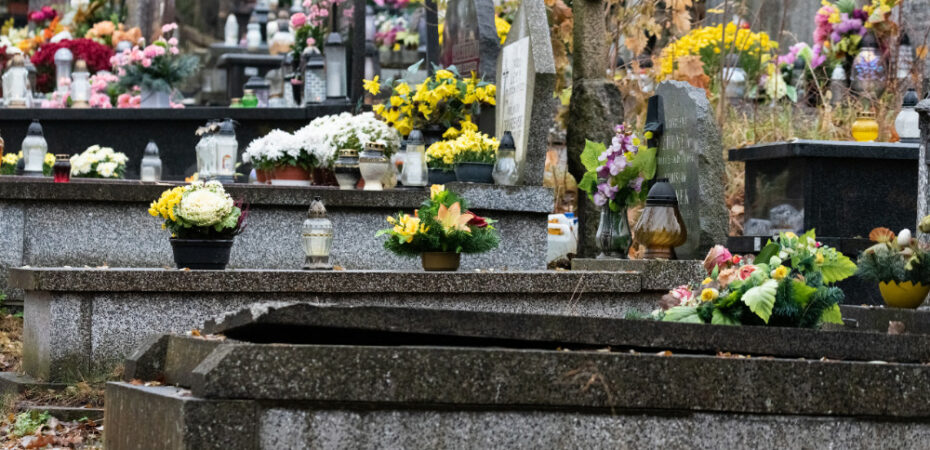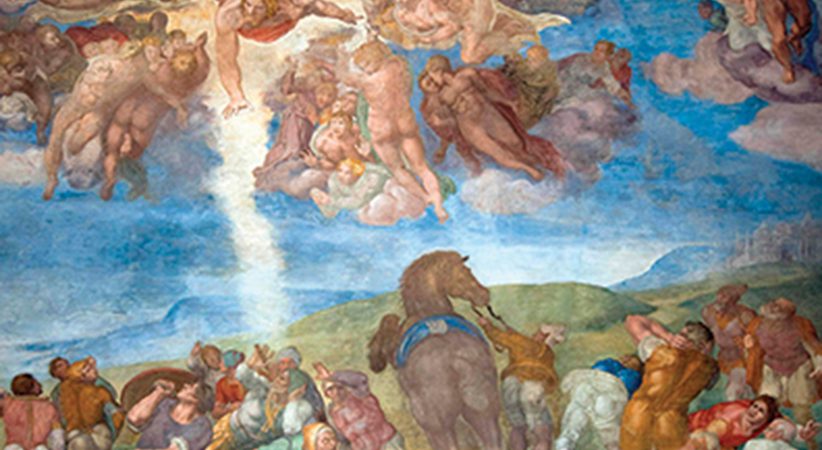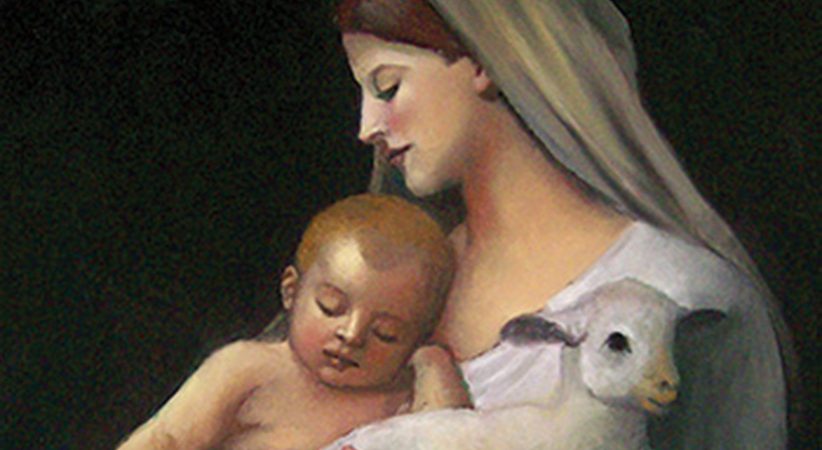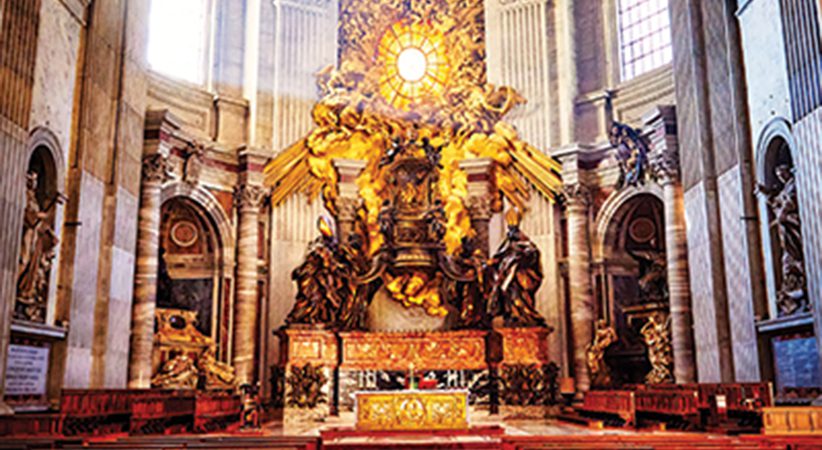What Makes a Catholic Cemetery Catholic?
We grieve and mourn, but the Church encourages us to honor death
D.D. Emmons Comments Off on What Makes a Catholic Cemetery Catholic?
Long ago, the Church designated two places as sacred: Catholic churches and Catholic cemeteries. “Sacred places are those which are designated to divine worship or to the burial of the faithful by the dedication or blessing which the liturgical books prescribe for that purpose” (Code of Canon Law, Canon 1205). A bishop is responsible for the blessing.
That cemeteries or places of burial are considered sacred can be traced at least to the early Egyptians who specially prepared the body for burial. In those times and for centuries later cemeteries were located outside city walls; case in point, the Crucifixion and the tomb of Christ were outside Jerusalem.
Eventually, Christian burial sites were located inside city walls including catacombs. With the growth of Christianity and the evolution of parishes, by the early Middle Ages parishioners were commonly buried in the yard adjacent to a church. The churchyard was part of the parish and the site was perfect to continually honor the deceased, but as time went by, that arrangement didn’t last. More and more, cemeteries were built at locations separate from the parish.
The importance of the churchyard cemetery as a Catholic burial spot is addressed by the 19th-century writer Ralston J Markoe: “I trust that no Catholic, and still less, any Catholic priest, will question the statement that the only proper place for a Catholic cemetery is immediately adjoining the church building. To have it anywhere else exposes us to the danger of forgetting that as we worship the Triune God, so we belong to the Triune Church, comprised of the church militant here on earth and the church triumphant in heaven” (“Impressions of a Layman,” Kessinger Publishing, $28.95).
That every parish has its own cemetery for its parishioners might be an ideal situation, but such is not the case. Today, Catholics who belong to a parish without a cemetery and desire to be buried in a Catholic cemetery pick from those managed by other parishes or the diocese.
According to Canon 1240: “1: Where possible, the Church is to have its own cemeteries or at least areas in civil cemeteries that are designated for the deceased members of the faithful and properly blessed. 2: If this cannot be achieved, however, then individual graves are to be properly blessed.”
Catholic End Care
Many sectors of society seek to deny and keep the angel of death at a distance, but not so the Catholic Church. While we mourn and grieve when a loved one dies, the Church encourages us to honor death — it is not the end but a change, “We shall not all fall asleep, but we will all be changed, in an instant, in the blink of an eye, at the last trumpet” (1 Cor 15:51-52).
We are made in God’s image, thus the Church pays homage to both the soul and the body with utmost respect.

This special care is a reflection of how Joseph of Arimathea and Nicodemus carefully prepared the crucified body of Our Lord (cf. Jn 19:38). They covered it with spices, wrapped it in a burial cloth and placed it in a new tomb. Their courageous actions were based on the love they had come to have for Jesus, not because they had a strong faith in his resurrection. Today, when Catholics bury someone, we have complete faith in their resurrection. The People of God resting in a Catholic cemetery lived with that same belief.
The Catechism of the Catholic Church directly addresses how we respect the dead: “The bodies of the dead must be treated with respect and charity, in faith and hope of the Resurrection. The burial of the dead is a corporal work of mercy; it honors the children of God, who are temples of the holy spirit” (No. 2300).
The high regard and respect for a deceased Catholic is further exemplified by the Church’s end-of-life rituals: confession, anointing of the sick, viaticum (the last rites), a wake or vigil, the funeral Mass, rite of committal, burial in the consecrated ground at a Catholic cemetery. Each of these rituals is focused on assisting the soul of the deceased along its journey to meeting with Christ at the particular judgment. Throughout each step, the Catholic priest provides comfort to the dying and the family.
On this path, the cemetery is the final stop and the place of rest for the mortal body until the final judgment. There are several reasons why a cemetery is designated as Catholic or, said another way, reasons that make a Catholic cemetery Catholic.
……………………………………………………………………………………………………………………………………………….
If a Catholic Cemetery Could Speak
Msgr. Jean-Joseph Gaume writes in “The Christian Cemetery in the Nineteenth Century” (CreateSpace Independent Publishing Platform, $5.57): “If you inquire, says the cemetery, why I have been so solemnly consecrated and hedged in with so much reverence, I reply that I am a reliquary designated to receive something holy. This holy and thrice holy relic is your body. As I am sanctified by a body, the body is sanctified by the soul. The body has been a temple, a sanctuary, a reliquary occupied by the soul, which is the living image of the God of all sanctity. To the cemetery, therefore, the human body is not what it is to the ‘solidaire’ a clod of mean earth. That the body is purified and sanctified by prayer and holy rite out of regard to the soul, is clear from the meaning of the prayers and ceremonies employed before it is carried to the grave.”
……………………………………………………………………………………………………………………………………………….
Consecrated Ground
First, as mentioned, a Catholic cemetery is blessed or consecrated ground. A bishop or his designee has the honor to impart a blessing on a new cemetery. He walks around the boundaries of the area while sprinkling holy water. He continues the sprinkling over the entire grounds. He offers several prayers petitioning God that the cemetery be kept free from unclean spirits, “And at the end of time, when the angels sound their trumpets, let all who have received the sacraments of baptism, who have persevered in the Catholic faith until death, and who have their remains laid to rest in this cemetery, be rewarded in body and in soul with the unending joy of heaven” (Roman Ritual, Part II, No. 4 Rite of Blessing a New Cemetery).
As time passes, the new cemetery becomes increasingly recognizable as Catholic by the manner and way a cemetery is adorned. The headstones, statues and images of saints, especially the Blessed Mother, of angels, the crucifix, the Pietà — all cry out the beliefs of those buried in this hallowed ground. Here we solemnly remember and pray for our beloved dead; we, too, seek some day to rest in such a sacred place. Management of the cemeteries, the values, standards and practices all reflect Catholic teaching.
“Therefore Catholics, both by law and by tradition, have chosen to be buried in Catholic cemeteries and this preference should continue. In this way, Catholics have the assurance that reverence and respect will be given to the remains of the deceased. Also, the Catholic cemetery, in reflecting the doctrines and liturgy of Catholic belief, maintains now in death the community of faith that was shared in life (Christian Burial Guidelines, Catholic Cemetery Conference, $10).
While by tradition many Catholics are buried in Catholic cemeteries, they are not obligated to do so (cf. Canon No. 1180).
Communion of Saints
The Church teaches us that there is an unbroken connection, a harmony, between those of us living and those faithful who have passed into either purgatory or heaven. We are all considered saints: those of us living are the Church Militant, we are responsible to pray for the souls in purgatory (Church Suffering), those in heaven, the Church Triumphant, pray for us.
The Catholic cemetery is a place we all have in common; we are one family of believers, a Communion of Saints. In life, no matter where they went to Mass, they were never strangers, and they are not strangers here. They received holy Communion every Sunday, went to Mass on Ash Wednesday, processed with the Blessed Sacrament to the altar of repose on Holy Thursday, adored the Cross on Good Friday, walked the Stations of the Cross, waited in line at confession, kept their palms until next year, carried out all those beautiful traditions of Catholicism.
As members of the Communion of Saints, the living can offer prayers on behalf of our sleeping brethren. The Mass is the ultimate prayer, and we can seek a Mass intention for the repose of the soul of those departed. The Eucharistic prayers of the Mass remember “our brothers and sisters who have fallen asleep in the hope of the resurrection, and all who have died in your mercy” (No. 2).
The priest says the prayers, and the congregation listening contemplates their deceased loved ones. In parishes, the entire month of November is given to remembering our departed friends and family. Masses are said and processions are sometimes conducted at Catholic cemeteries honoring the dead. It is not unusual that the diocesan bishop will say Mass remembering the deceased in all the cemeteries of the diocese — especially during November. The Catholic cemetery calls to mind the fidelity that exists in the Communion of Saints, that the dead are not forgotten, that they continue to be honored.
D.D. EMMONS writes from Pennsylvania.
…………………………………………………………………………………………………………………………………………
Indulgences — Visits to a Cemetery
We as the Church Militant can eliminate or reduce a person’s time in purgatory by obtaining an indulgence on their behalf. This act is one of eternal value for the deceased who are now incapable of helping themselves. The Manual of Indulgences (USCCB, $19.95), for the faithful departed, reads:
“A Plenary indulgence, applicable only to the souls in purgatory, is granted to all the faithful who,
“No. 1. On any and each day from November 1 to 8, devoutly visit a cemetery and pray, if only mentally for the departed;
“No. 2. On All Souls’ Day, (or, according to the judgment of the ordinary, on the Sunday preceding or following it, or on the solemnity of All Saints), devoutly visit a church or oratory and recite an Our Father and the Creed.
“A partial indulgence for the souls in purgatory can be obtained by visiting a cemetery at any time and pray for the dead, or devoutly recite lauds and vespers from the office of the dead or the prayer Eternal Rest.”
Of course, seeking an indulgence necessitates accomplishing all the prerequisites associated with gaining this great gift.
…………………………………………………………………………………………………………………………………………





